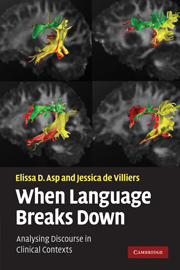Book contents
- Frontmatter
- Contents
- List of figures
- List of tables
- Acknowledgements
- Transcription conventions
- Introduction
- 1 Introduction to clinical discourse analysis
- 2 Theoretical and clinical contexts
- 3 Talk and speech – conversation analysis and intonation in English
- 4 Grammar
- 5 Phase and contexts of culture and situation
- 6 Study design
- 7 Differential diagnosis and monitoring
- 8 Cognitive models, inferencing and affect
- 9 Modelling information across domains
- Closing remarks
- Notes
- Appendix A Some basic grammatical terminology and relations
- Appendix B Inventory of codes
- References
- Author index
- Subject index
9 - Modelling information across domains
Published online by Cambridge University Press: 05 June 2012
- Frontmatter
- Contents
- List of figures
- List of tables
- Acknowledgements
- Transcription conventions
- Introduction
- 1 Introduction to clinical discourse analysis
- 2 Theoretical and clinical contexts
- 3 Talk and speech – conversation analysis and intonation in English
- 4 Grammar
- 5 Phase and contexts of culture and situation
- 6 Study design
- 7 Differential diagnosis and monitoring
- 8 Cognitive models, inferencing and affect
- 9 Modelling information across domains
- Closing remarks
- Notes
- Appendix A Some basic grammatical terminology and relations
- Appendix B Inventory of codes
- References
- Author index
- Subject index
Summary
Introduction
As we outlined in Chapter 5, the term context may be used to refer to a variety of apparently rather different constructs including the physical and social environments in which communication takes place, common patterns of interaction that might occur in those settings, as well as meanings made relevant by ongoing events and discourse. Our use of the term context includes these senses, but interprets them specifically as information available to speakers. This information is acquired, some of it actively ‘learned’, in interactions which individuals participate in and is represented in episodic, semantic, linguistic and other repertoires. Speakers use this acquired and learned information to interpret what is happening, to shape responses to new, incoming, information and to communicate. We use context of culture, context of situation and phase to describe information relevant for interpretation of particular texts or discourses. Respectively, these reflect broad patterns of culture associated with language and dialect variation, situation types which constitute patterns of culture, and the specific discourses which instantiate culture and situation. We are interested in instances of discourse because new information is acquired ‘live’, moment by moment in situations and because examining instances allows us to observe discourse behaviour which may be clinically relevant and from which generalizations may be abstracted and related to other evidences of neurocognitive integrity and function.
- Type
- Chapter
- Information
- When Language Breaks DownAnalysing Discourse in Clinical Contexts, pp. 168 - 206Publisher: Cambridge University PressPrint publication year: 2010



